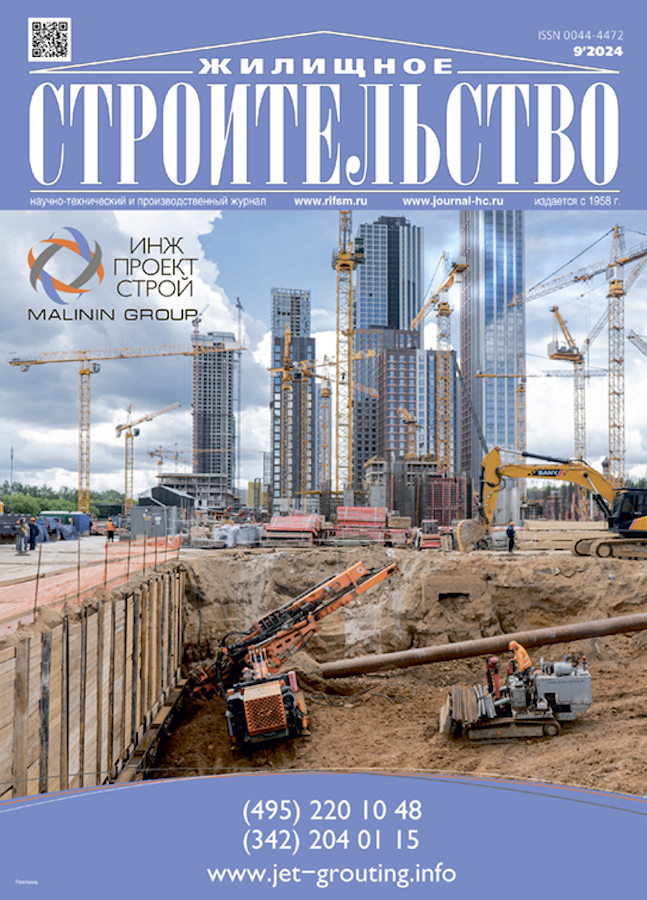Закономерности изменения механических и фильтрационных свойств полускальных грунтов, модифицированных струйной цементацией
- Авторы: Зуев С.С.1, Маковецкий О.А.2
-
Учреждения:
- АО «Нью Граунд»
- Пермский национальный исследовательский политехнический университет
- Выпуск: № 9 (2024)
- Страницы: 30-35
- Раздел: СТАТЬИ
- URL: https://ter-arkhiv.ru/0044-4472/article/view/642650
- DOI: https://doi.org/10.31659/0044-4472-2024-9-30-35
- ID: 642650
Цитировать
Полный текст
Аннотация
При устройстве подземных сооружений в слоях грунта с высокими скоростями фильтрации подземных вод предъявляются особые требования к материалу противофильтрационных завес. Рассматриваются условия применения технологии струйной цементации для модификации обводненных трещиноватых скальных грунтов низкой прочности с целью формирования композитного материала с требуемыми механическими и фильтрационными характеристиками. Экспериментально и теоретически определены технологические параметры процесса цементации, обеспечивающие необходимый радиус распространения скрепляющей смеси, разработаны методы лабораторного и полевого контроля модифицированной зоны. Определены предельно допустимые значения контролируемых параметров.
Полный текст
Об авторах
С. С. Зуев
АО «Нью Граунд»
Автор, ответственный за переписку.
Email: office@new-ground.ru
зам. ген. директора
Россия, 614081, г. Пермь, ул. Кронштадтская, 35О. А. Маковецкий
Пермский национальный исследовательский политехнический университет
Email: office@new-ground.ru
д-р техн. наук
Россия, 614000, г. Пермь, Комсомольский пр., 29Список литературы
- Зерцалов М.Г., Конюхов Д.С., Меркин В.Е. Использование подземного пространства. М.: АСВ, 2015. 416 с.
- Астраханов Б.Н. Тенденции развития технологии устройства ограждения котлованов в условиях плотной городской застройки // Основания, фундаменты и механика грунтов. 2002. № 4. С. 4–8.
- Адамович А.Н. Закрепление грунтов и противофильтрационные завесы. М.: Энергия, 1980. 320 с.
- Тер-Мартиросян З.Г., Тер-Мартиросян А.З. Напряженно-деформированное состояние массивов грунтов под воздействием гидрогеологических факторов // Вестник МГСУ. 2008. № 2. С. 150–157.
- Шапиро Д.М. Теория и расчетные модели оснований и объектов геотехники. М.: АСВ, 2016. 180 с.
- Henn Raymond W. Practical guide to grouting of underground structures. American Society of Civil Engineers. 1996. 200 p.
- Moseley M.P. Ground improvement. London. 2004. 440 p.
- Karol Reuben H. Chemical grouting and soil stabilization. American Society of Civil Engineers. 2003. 536 p.
- Makovetskiy O., Zuev S. Practice device artificial improvement basis of soil technologies jet grouting // Procedia Engineering. 2016. Vol. 165, pp. 504–509.
- Маковецкий О.А., Конюхов Д.С., Зуев С.С. Опыт применения струйной цементации для устройства противофильтрационной завесы в скальных грунтах // Жилищное строительство. 2020. № 9. С. 27–33. https://doi.org/10.31659/0044-4472-2020-9-27-33
- Абелев М.Ю., Абелев К.М. Геотехнические исследования площадок строительства, сложенных слабыми водонасыщенными глинистыми грунтами // Геотехника. 2010. № 6. С. 30–33.
- Шашкин А.Г. Проектирование зданий и подземных сооружений в сложных инженерно-геологических условиях Санкт-Петербурга. М.: Геомаркетинг, 2014. 352 с.
- Коновалов П.А., Зехниев С.Г., Безволев С.Г. Расчет эффективности укрепления слабых оснований нагружением, дренированием и армированием // Основания, фундаменты и механика грунтов. 2003. № 1. С. 2–8.
- Бройд И.И. Струйная геотехнология. М.: АСВ, 2004. 448 с.
- Хямяляйнен В.А., Майоров А.Е. Особенности течения цементационных растворов при упрочнении трещиноватых горных пород // Горный информационно-аналитический бюллетень. 2012. № 10. С. 199–205.
- Шубин А.А. Моделирование процесса ликвидации подземных пустот в условиях техногенной активации // Записки горного института. 2013. Т. 204. С. 101–104.
- Платонов А.П., Першин М.Н. Композиционные материалы на основе грунтов. М.: Химия, 1987. 144 с.
- Куликова Е.Ю. Показатели надежности, безопасности и риска при химическом укреплении грунтов // Известия высших учебных заведений. Горный журнал. 2009. № 8. С. 43–49.
Дополнительные файлы














